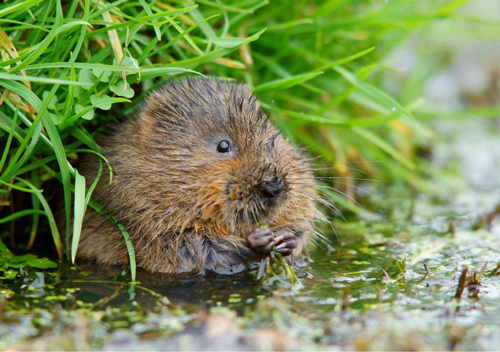Environment
Water voles

The water vole (arvicola amphibius) is Britain’s largest vole, weighting between 200g to 350g as an adult. They have a blunt muzzle, round body and short round ears almost entirely hidden in their fur, with a hairy tail roughly half their body length. A similar looking and often misidentified species is the brown rat (rattus norvegicus), but as you can see from the photo they have a pointier muzzle, more obvious pronounced ears and a long almost bald tail compared to a water vole.
Burrows in the bank
Water voles require steep or stepped banks next to slow flowing water bodies with relatively stable water levels. This is to create a series of burrows in the bank, comprising of food storage, residential areas and nest chambers with interconnecting tunnels and entrances. A nest consists of shredded grass and is usually created higher up the bank above the water level. Occasionally nests are woven into a large ball of vegetation at the base of reeds and sedges, but this usually only occurs in wetlands with a high water table.
Food source
Bankside and aquatic vegetation are a necessity for water voles. They provide cover and protection from predation. It also serves as a food source as they are herbivorous and will feed on a variety of lush plant stems, bulbs and roots and also in some circumstances flowers during pregnancy for the protein-rich pollen.
Protected wildlife
Water voles are currently protected under the Wildlife and Countryside Act 1981 (as amended) from killing or taking by certain prohibited methods. It is an offence to damage, destroy, disturb or obstruct their breeding and resting places.
